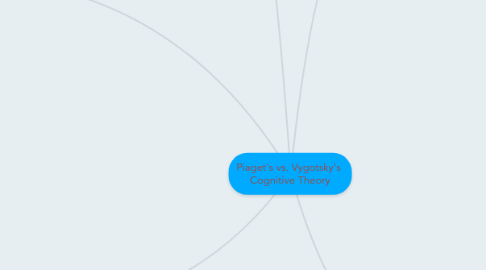
1. Piaget's Cognitive Theory
1.1. Assimilation and accommodation
1.1.1. The way children acquire new information into their world. Assimilation allows the child to increase information in to a preexisting schema. Accommodation is different in the child has to make room in their brain to understand the new object, event or ideas.
1.2. Constructivism
1.2.1. The way children form their thoughts and integrate them not passively absorbing information at random age they will move through Piaget’s four stages. Birth sensorimotor, 2 preoperational; 6 - 7 concrete operational, 11- 12 formal operational, pg. 29.
2. Vygotsky's Cognitive Theory
2.1. Mediated Learning Experience
2.1.1. Discussion between an adult and a child in which the adult helps the child make sense of an event they are mutually experiencing. Example: An example of this would be when reading stories as a class and sharing experiences to help students connect to events in the story where they may not have life experiences to relate to the story.
2.2. Zone of Proximal Development
2.2.1. Range of tasks that a learner can perform with the help and guidance of others but cannot yet perform independently. Example: When reading a children’s story book I would stop and do a think aloud, so my students could understand what was taking place in my brain as I read, for example I would ask a question like, ”why would the author have the character do that?”
2.3. Sociocultural Theory
2.3.1. Emphasizing the importance of society and culture in promoting learning and development.
3. Applications
3.1. Piaget
3.1.1. When teaching child about different cultures you can use different foods. You can start with a familiar piece of fruit most children know, say an apple or banana, than have them assimilate a coconut, and pineapple which most are able to assimilate with prior knowledge. Then show them a papaya, star fruit, and kumquat, etc. They need to make room to accommodate the new fruit. If some recognize these fruits you can make insure enough is brought so accommodation occurs. We discuss where the new fruit comes from and the different taste.
3.1.2. The Concrete Operations stage consist of adult like logic and most children can classify objects as belonging to two or more categories. You can give them a lesson on animals and how some belong to different groups called mammals, amphibian and reptiles and still have individual names. They comprehend this by age 7 usually. Presentation by PowerPoint would be educational or a hands on field trip.
3.2. Vygotsky's
3.2.1. Students can work through the steps of writing a research paper in first semester, in second semester they actually go through the process again, this time they write the entire research paper using the skills they learned earlier in the course along with newly introduced information about credible resources and differences between primary and secondary resources. Scaffolding is often used in 21st century classrooms to help students accomplish tasks in smaller parts to achieve the whole concept.
4. Compare/Contrast
4.1. Compare
4.1.1. Social forces set the limit of development.
4.1.2. Development occurs because the children are active learners
4.1.3. Development declines with age
4.1.4. Development may be initiated by cognitive conflict
4.1.5. There is an end point to cognitive development - birth to adolescence
4.2. Contrast
4.2.1. Piaget
4.2.1.1. There is an end point to cognitive development, birth to adolescence
4.2.1.2. A child’s constructs his/her own knowledge
4.2.2. Vygotsky
4.2.2.1. A child is scaffolded by an adult or peer who is more capable than the child
4.2.2.2. Learning begins at birth and ends at death
4.2.2.3. Children learned through culture and social interaction
5. Cognitive Development
5.1. Jennifer
5.1.1. The way in which people's cognitive abilities develop over time from their interactions with the world
5.2. Toni
5.2.1. The development of a thought process which changes as you age and have new experiences
5.3. Susan
5.3.1. Connecting ones mental capabilities to the task of processing information from birth to death.
5.4. Group
5.4.1. The way in which people's cognitive abilities develop from birth to death from their interactions with the world.
